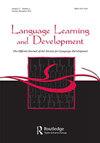Thanks or Tanks: Training with Tactile Cues Improves Learners’ Accuracy of English Interdental Consonants in an Oral Reading Task
IF 1.4
2区 文学
0 LANGUAGE & LINGUISTICS
引用次数: 2
Abstract
ABSTRACT The present study investigates whether training second language pronunciation with tactile cues facilitates the production of non-native sounds involving accessible articulatory features. In a between-subjects experiment with a pretest-training-posttest design, 50 Turkish learners of English received audiovisual training on a set of target words and sentences containing two English interdental fricatives, /θ/ and /ð/, in one of two conditions, tactile and non-tactile. The tactile condition involved self-touching the tongue as it protruded during pronunciation of the two target sounds. Participants’ pronunciation performance was assessed through a word-imitation task, a sentence-imitation task, and a discourse reading task. Results showed that while both training conditions helped learners to improve their pronunciation performance in all three tasks, the tactile condition triggered greater improvements in the discourse reading task. These results extend previous findings on the benefits of tactile input for speech perception and suggest the efficacy of multisensory training paradigms for improving second language pronunciation.感谢还是感谢:触觉提示训练提高学习者在口语阅读任务中英语齿间辅音的准确性
摘要本研究旨在探讨用触觉提示进行第二语言发音训练是否能促进涉及可接近发音特征的非母语语音的产生。实验采用前测-训练-后测设计,对50名土耳其英语学习者在触觉和非触觉两种条件下,接受了一组包含/θ/和/ð/两个英语齿间摩擦音的目标单词和句子的视听训练。触觉条件包括在发音两个目标音时舌头伸出时自我触摸。参与者的发音表现通过单词模仿任务、句子模仿任务和语篇阅读任务来评估。结果表明,虽然这两种训练条件都有助于学习者在所有三个任务中的发音表现,但触觉条件在语篇阅读任务中引发了更大的改善。这些结果扩展了先前关于触觉输入对语音感知的益处的发现,并表明多感官训练范式对改善第二语言发音的有效性。
本文章由计算机程序翻译,如有差异,请以英文原文为准。
求助全文
约1分钟内获得全文
求助全文

 求助内容:
求助内容: 应助结果提醒方式:
应助结果提醒方式:


